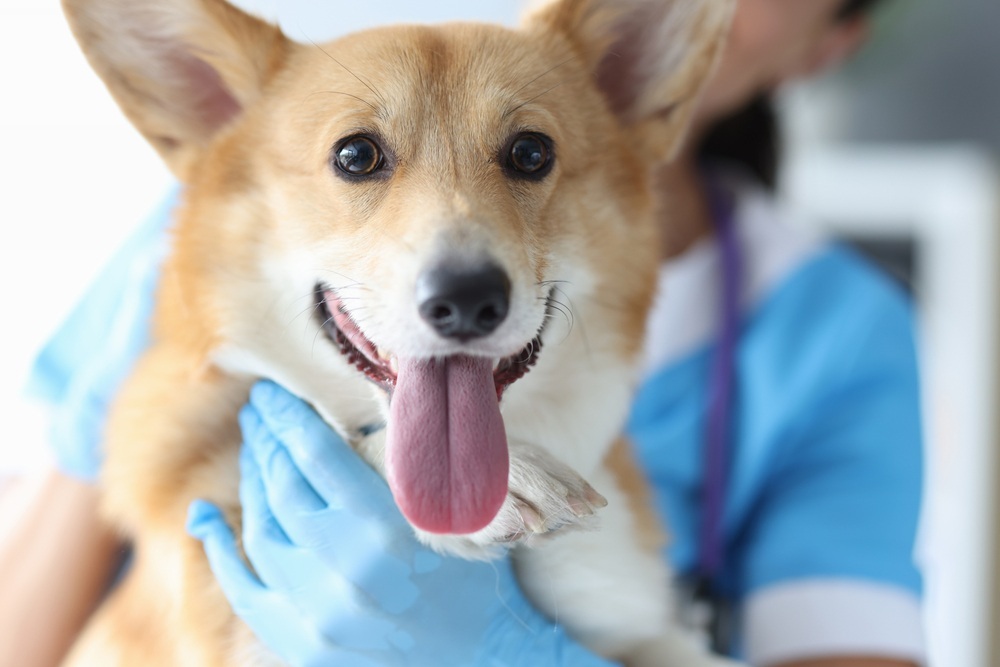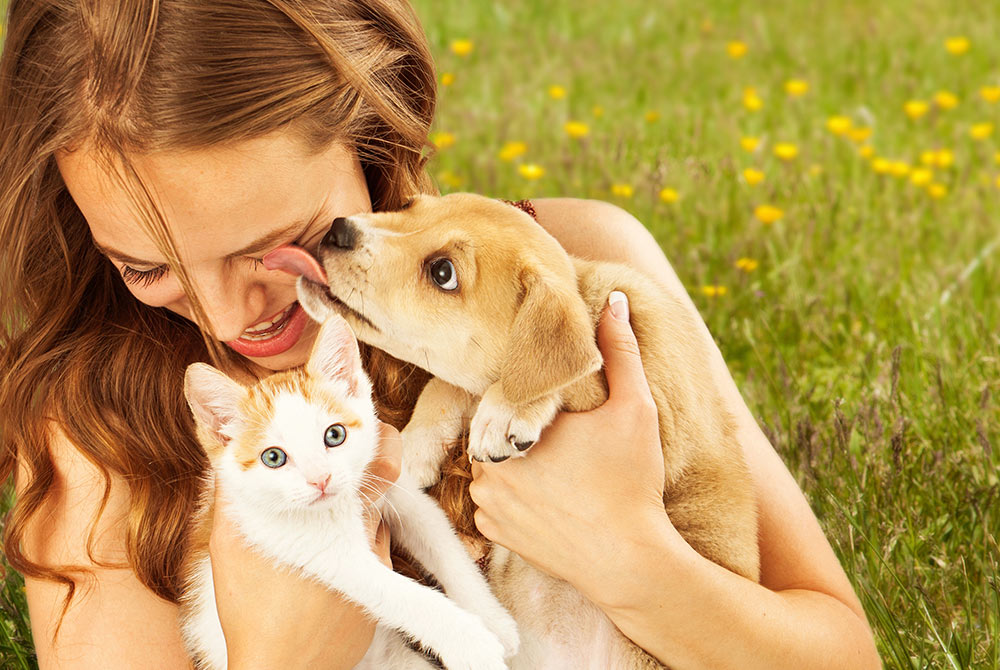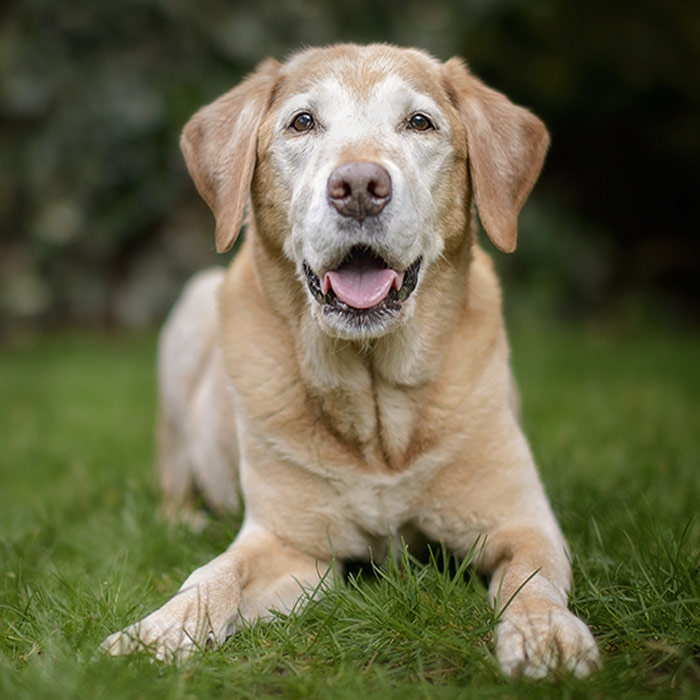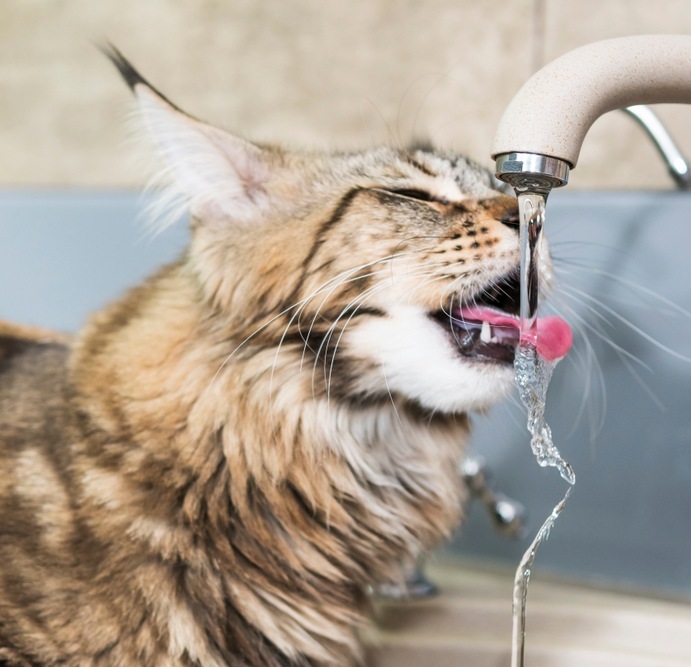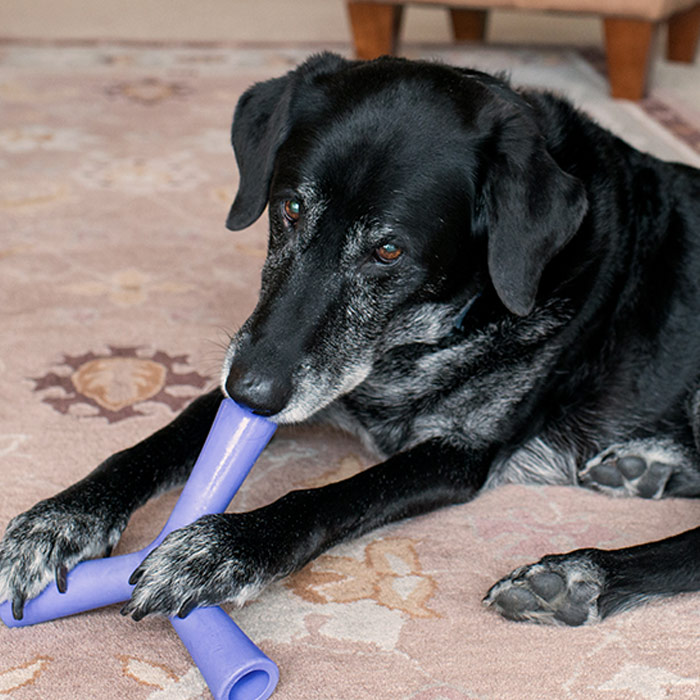Hypothyroidism in dogs and cats
What is hypothyroidism in dogs and cats?
The thyroid is a two-lobed gland located in the neck, near the voice box. It produces thyroid hormones, known as T3 and T4, which regulate the body’s metabolism and affect many processes of the body. If too little thyroid hormone is produced, these processes become sluggish; if too much is produced, they run too fast. Hypothyroidism, also called “underactive thyroid” (in medical terms, “hypo-“ means low, under, beneath or below normal), is characterised by a decrease of thyroid hormones, resulting in a slower metabolic rate.
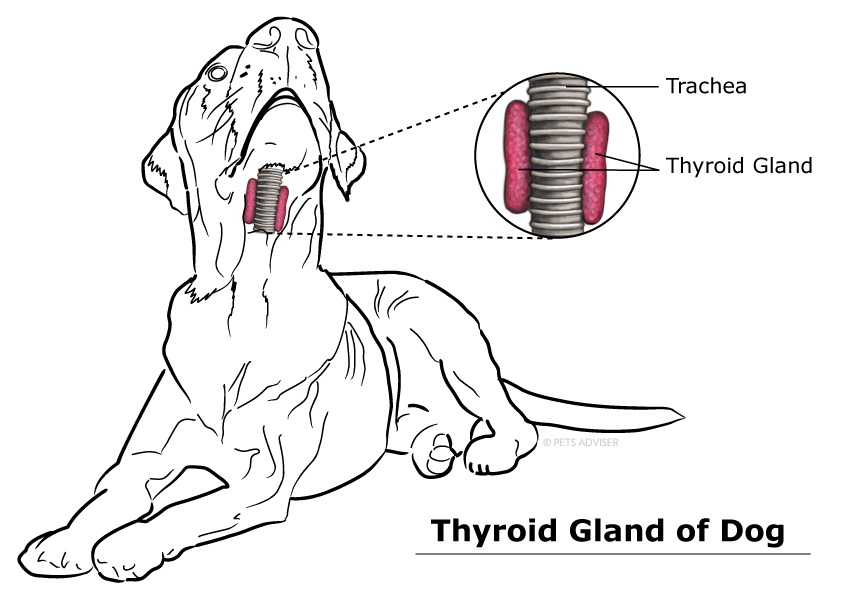
Hypothyroidism is a common canine disease – it is in fact the most common hormone imbalance occurring in dogs. Found most often in middle-aged to older dogs, the average age at diagnosis is 7-years. It usually affects mid- to large-size breeds and rarely occurs in toy and miniature breeds. Breeds with a predisposition to this condition include the Golden Retriever, Doberman Pinscher, Great Dane, Boxer, Irish Setter, Miniature Schnauzer, Dachshund, Cocker Spaniel, and Airedale Terrier. Hypothyroidism occurs equally in both male and female dogs, but spayed females appear to have a higher risk than unspayed dogs.
Hypothyroidism is a rare condition in cats; when it does occur, it is usually after treatment for hyperthyroidism, a much more common feline condition in which the thyroid gland overproduces thyroid hormones. In most cases, hypothyroidism in cats is transitory and does not require ongoing therapy.
Cost of hypothyroidism in dogs
Average claim cost |
Highest claim cost |
No of dogs affected in 2022 |
| $388Ø | $4,747Ø | 1,799Ø |
ØBased on PetSure claims data, 2022 calendar year. Reimbursement for these claims under a pet insurance policy would be subject to limits, such as annual benefit limits or sub-limits, benefit percentage, applicable waiting periods and any applicable excess. Cover is subject to the policy terms and conditions. You should consider the relevant Product Disclosure Statement or policy wording available from the relevant provider. Please note that values calculated are based on all claims for that condition and medically related conditions in each calendar year.
Because it is difficult to predict the costs of veterinary care, it can help to have measures in place to help prepare for the unexpected. Pet insurance can help by covering a portion of the eligible vet bill if the unexpected does happen.
Get a quote for 2 months free pet insurance for your puppy or kitten in their first year.
Symptoms of hypothyroidism in dogs and cats
Physical symptoms
Because the thyroid hormones affect nearly every cell in the body, reduced levels of thyroid hormone often cause symptoms and secondary problems in multiple body systems. The physical symptoms of hypothyroidism can vary greatly, but they are mostly related to the slowing metabolism. In animals with mild disease, physical symptoms may be mild or absent.
For example, a dog with hypothyroidism may become listless and easily fatigued, sleep for longer periods of time, and seek a warm area in cold weather. She may appear puffy, especially on her forehead and face, as the skin and skinfolds above the eyes become thickened. Her hair coat may become dry and lose its sheen, the hair may become very sparse – especially in areas of friction – leading to bald spots, and the underlying skin may darken. She may become prone to skin infections and poor wound healing, as well as many internal health problems. The rare cat with hypothyroidism may have similar physical symptoms.
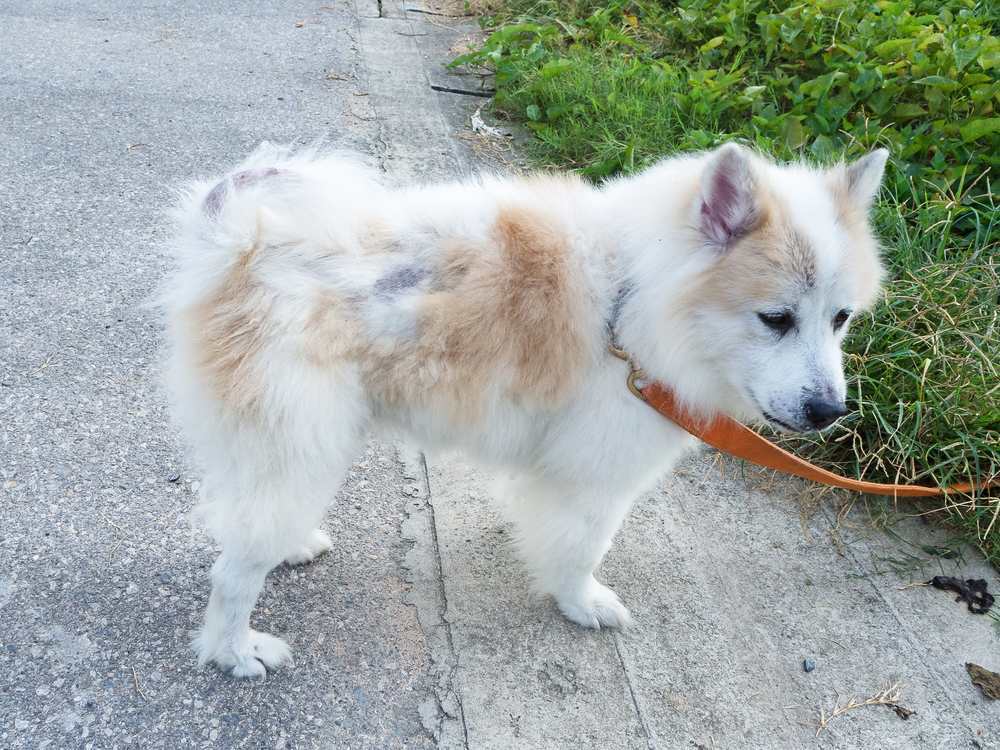
Some of the more common physical symptoms include:
- Weight gain, obesity (without an increase in appetite)
- Changes in coat and skin – dryness, increased shedding, hair thinning, hair loss, balding, increased pigmentation
- Thickening of the facial skin (giving the face a “tragic” expression)
- Seizures with sudden onset occurring in adult dogs
- Decreased appetite
- Obesity
- Lethargy
- Exercise intolerance
- Cold intolerance
- Low body temperature
- Increased susceptibility to skin and ear infections
- Reproductive disturbances in intact dogs
- High blood cholesterol
- Slow heart rate
Unsure how serious it is?
Bow Wow Meow policyholders can get access to trusted vet care anytime, anywhere, at no additional cost. Connect to an experienced Australian registered vet via video call, 24/7. Whether it’s providing vet advice, setting up at-home treatment plans, or confirming if you need to visit a vet in person, you can get help when you need it.
Find out more about our pet insurance cover options.
Behavioural symptoms in dogs
Hypothyroidism in dogs can sometimes manifest in uncharacteristic and bizarre behaviours. Often, these behavioural symptoms appear suddenly and precede more commonly known physical symptoms such as weight gain and coat changes. For example, a usually quiet, well-mannered and sweet-natured dog may unexpectedly exhibit behaviours such as aggression, moodiness, bad-temperedness, lack of concentration, depression, mental dullness, anxiety, fearfulness and / or disorientation. Behavioural symptoms are typically erratic in occurrence and the dog can appear to be almost in a trance-like state during their occurrence. The rare cat with hypothyroidism may exhibit similar behavioural symptoms.
Typical behavioural signs may include:
- Unexplainable aggression towards other dogs and/or people and/or objects
- So-called ‘rage-syndrome’
- Mental dullness
- Phobias
- Disorientation
- Drastic personality change
- Extreme shyness
- Fearfulness
- Retreating
- Seizures, sometimes accompanied by aggressive behaviour immediately before or after
- Inattentiveness
- Depression
- Anxiety
- Irritability
Aggression as a behavioural symptom of hypothyroidism
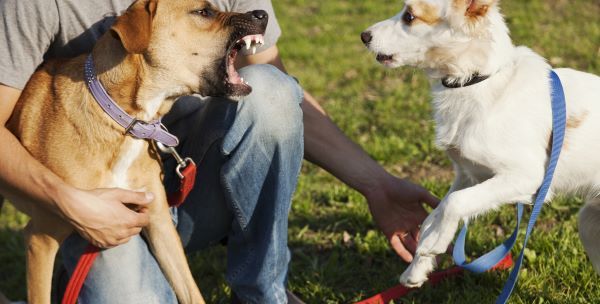
Hypothyroidism in dogs can in some cases cause sudden, unprovoked aggression towards other animals, people or even inanimate objects. Aggression can occur in the absence of any other symptoms of hypothyroidism. Where the presenting symptom in a dog is aggression, it is reasonable to investigate the possibility of hypothyroidism related aggression. In some cases, hypothyroidism may be the primary cause of aggression and in others, it may be an aggravating factor.
Unfortunately, many dog owners and even veterinarians are unaware that behavioural symptoms can be caused by hypothyroidism, and these highly undesirable behaviours can tragically result in the animal being euthanised because the owner is no longer able to manage him or her. Therefore, if your dog suddenly begins displaying uncharacteristic behaviours – particularly aggression – it is very important to pay a visit to the vet for a thorough physical examination and possible thyroid testing.
The biological link between aggression and hypothyroidism is not completely understood, but it could relate to serotonin levels. Serotonin is one the main neurotransmitters involved in the control of aggression, and it is thought that hypothyroidism can decrease the production of serotonin which can in turn lower the threshold of aggression.
Causes of hypothyroidism in dogs and cats
More than 95% of cases of hypothyroidism in dogs are caused by the body’s own destruction of the thyroid gland, leading to a natural deficiency of thyroid hormone. This destruction is usually the result of one of two diseases:
- Lymphocytic thyroiditis, an autoimmune disorder where immune cells attack the thyroid gland and affect the production of thyroid hormone, is the more common cause. It is not clear why this occurs, but it appears that genetics plays a role.
- Idiopathic atrophy of the thyroid gland, a poorly understood condition where normal thyroid tissue is replaced by fat tissue.
The remaining 5% of cases in dogs are caused by rare diseases, including:
- Tumour of the thyroid gland or of the pituitary gland (the thyroid gland is controlled by the pituitary gland, which is located at the base of the brain).
- Congenital defects, such as being born with a thyroid gland that does not develop or function normally. Dogs that are born with thyroid deficiency or that develop it early in life often show dwarfism and impaired mental development. Those born with a pituitary disorder, such as pituitary dwarfism, can also have hypothyroidism.
In cats, the most common cause of hypothyroidism is treatment for hyperthyroidism by surgical removal (thyroidectomy) or by means of radioiodine therapy or antithyroid drugs. Although naturally occurring hypothyroidism is extremely rare in cats, when it does occur, it appears to be due to a disorder in the thyroid gland itself (rather than in the pituitary gland, as is seen in some other animals). Congenital and adult-onset forms of the disease can occur in cats but are considered extremely rare.
How is hypothyroidism in dogs and cats diagnosed?
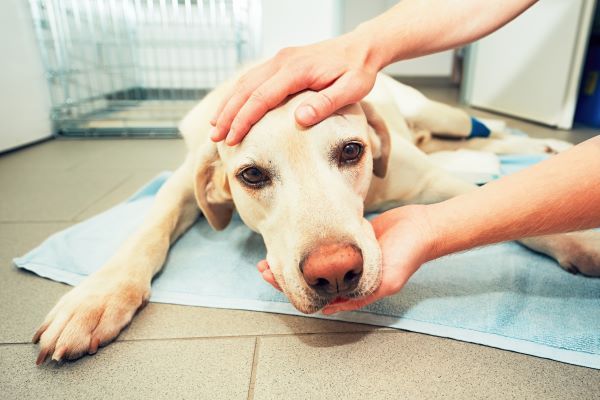
The veterinarian will require a thorough history of your pet’s health leading up to the onset of symptoms and will carry out a physical examination. Several blood tests and other additional testing may be necessary to definitively determine if the animal is suffering from hypothyroidism, including:
- Routine blood tests (complete blood count, biochemistry profile and urinalysis)
- A test of thyroid hormone (especially T4) concentration in the blood
- Administration of thyroid-stimulating hormone (THS)
- Radiographic studies (ultrasonography or scintigraphy) of the thyroid gland
- A therapeutic drug trial
- Antibody testing
A measure of T4 in conjunction with TSH levels are the tests preferred by most vets. A low level of T4 together with an increased TSH value leads to a diagnosis of hypothyroidism. If the results are not conclusive, a treatment trial with a thyroid drug should be done.
It is important to be aware that in some cases, diagnosis can be difficult and repeated testing will be necessary. Because of the importance of the thyroid hormones in metabolism, many organ systems can be affected, and a multitude of varying and puzzling symptoms are possible. Diagnostic tests can be just as confusing as the symptoms. The MSD Veterinary Manual states that hypothyroidism is probably one of the most over-diagnosed diseases in dogs; this is because many diseases mimic hypothyroidism, and some of these conditions or their clinical signs even improve with thyroid medication. Other diseases may also affect the thyroid levels but are not hypothyroidism.
Serum T4 concentrations
This is a good initial screening test for hypothyroidism because low T4 levels in the blood can be indicative of hypothyroidism. However, lower serum levels of T4 and similar signs can result from other diseases, so diagnosis cannot be made solely based on this test. Additionally, certain dog breeds, such as sighthounds, generally have lower T4 blood levels than other breeds, while some drugs, such as glucocorticoids, can reduce blood levels of T4 (these dogs will have low T4 serum levels but are not hypothyroid).
This means that a normal T4 concentration indicates normal thyroid function, but a low T4 concentration may or may not indicate hypothyroidism. There is also a grey zone where T4 levels are considered not definitively normal and not definitively abnormal. In short, T4 testing alone is not sufficient to make a diagnosis of hypothyroidism. When in doubt, the vet can do more extensive thyroid hormone testing, including blood tests to look at free T4, total T4, total T3, and TSH.
TSH stimulation test
 Animals with primary hypothyroidism – by far the most common type – would be expected to have low serum T4 along with high concentrations of thyroid-stimulating hormone (TSH). This is because the pituitary gland should be secreting high levels of TSH in a futile attempt to stimulate an under-performing thyroid gland.
Animals with primary hypothyroidism – by far the most common type – would be expected to have low serum T4 along with high concentrations of thyroid-stimulating hormone (TSH). This is because the pituitary gland should be secreting high levels of TSH in a futile attempt to stimulate an under-performing thyroid gland.
TSH can be directly measured in the bloodstream. The TSH stimulation test evaluates the response of the thyroid gland to exogenously administered TSH. It is an accurate test of thyroid function in dogs, but its use is limited by the expense and limited availability of TSH. Additionally, many dogs (approximately 25%) with true hypothyroidism do not exhibit the elevated TSH levels one would expect. While this test is often helpful in making the diagnosis of hypothyroidism, serum TSH results should not be evaluated alone but always in combination with the animal’s history, clinical signs, routine laboratory test findings, and low T4 concentrations. Note that while a feline specific TSH assay is not currently available, the canine TSH assay can be used as a test for feline hypothyroidism.
Testing with a trial of medication
Sometimes the most effective test for hypothyroidism is to simply administer a thyroid medication for several months and assess the results. Often an improvement in attitude and energy level is seen within the first week. Re-growth of hair usually takes substantially longer – typically 4 months or more – as the follicles must reawaken and then grow a hair long enough to be visible.
Prognosis
The prognosis for cats with hypothyroidism is excellent, with the condition often resolving without treatment. Follow up blood work is necessary to make sure that the thyroid hormone concentrations are improving on their own. Thyroid hormone supplementation may be needed in some cats for a period.
Hypothyroidism in dogs has no cure, but the condition is treatable and usually responds well to appropriate medication, with a rapid improvement in energy levels and other physical symptoms once treatment is started. Additionally, the prognosis for hypothyroidism related aggression is usually good and improvement is often observed within a few weeks of commencing treatment.

Treatment for hypothyroidism in dogs and cats
Hypothyroidism in dogs is treatable and usually responds well to an oral thyroid hormone supplementation, such as thyroxine. Treatment is generally lifelong, with the dosage depending on the dog’s weight and thyroid levels. However, determining the right dosage of the thyroid supplement can take time.
 The success of treatment can be measured by the degree of improvement in the dog’s symptoms. Most animals show improvement in many of the physical symptoms between two days to two weeks. Usually, any changes in coat and body weight will be evident after one to two months, while regrowth of the hair and lightening of the skin may take several months.
The success of treatment can be measured by the degree of improvement in the dog’s symptoms. Most animals show improvement in many of the physical symptoms between two days to two weeks. Usually, any changes in coat and body weight will be evident after one to two months, while regrowth of the hair and lightening of the skin may take several months.
If the dog has exhibited behavioural symptoms such as aggression or agitation, evidence suggests that thyroid hormone treatment can resolve or reduce these behaviours in many cases. Your vet may prescribe thyroid medication, supplements and/or alternative remedies for their potential calming effect. If no improvement occurs after a few months of treatment, behaviour therapy may be recommended.
Dogs with hypothyroidism will most likely need to have their thyroid levels retested once or twice a year to determine if their current dosage is adequate; if not, further adjustment is required. If your dog does not improve after a few months on thyroid medication, another disorder could be responsible, and further tests should be performed.
In cats, usually no treatment is required for hypothyroidism, as the condition is frequently transitory. If your vet determines that treatment is required, it will usually be lifelong, although most symptoms should resolve after a few months of commencement. Treatment entails administering a synthetic form of thyroid hormone, with the dosage based on the cat’s physical condition and improvement in signs. Once the dose has been stabilized, thyroid hormone levels are usually monitored once or twice a year. Only the vet should determine whether the dosage should be changed. Most cats respond well to therapy, with activity levels and mental alertness increasing significantly in a short amount of time.
Overview
Hypothyroidism (underactive thyroid) results from decreased thyroid hormone production by the thyroid glands, resulting in a slower metabolic rate. Hypothyroidism is the most common hormone imbalance in dogs but is rare in cats. It typically develops in middle aged to elderly dogs, with the average age at diagnosis being 7 years. Some breeds do appear to be at greater risk of developing hypothyroidism than others, typically medium-to-large-size breeds.
In 95 percent of cases, the direct destruction of the thyroid gland causes hypothyroidism. Symptoms vary greatly because many of the body’s systems are affected and behavioural symptoms such as aggression can also occur. Accurate diagnosis requires close evaluation of signs and various laboratory tests, including a finding of low blood concentrations of thyroid hormones (especially T4) in combination with high levels of thyroid-stimulating hormone. Treatment involves replacement with synthetic thyroid hormone, typically thyroxine (T4). Ongoing monitoring and testing are required, and the vet may need to adjust the dosage over time.
More information
- https://veterinarypartner.vin.com/default.aspx?pid=19239&id=4952004
- https://veterinarypartner.vin.com/default.aspx?pid=19239&id=4951353
- https://www.msdvetmanual.com/dog-owners/hormonal-disorders-of-dogs/disorders-of-the-thyroid-gland-in-dogs
- https://www.akc.org/expert-advice/health/thyroid-disease-in-dogs/
- https://vcahospitals.com/know-your-pet/hypothyroidism-in-dogs
- https://www.whole-dog-journal.com/health/help-for-dogs-with-hypothyroidism/
- https://www.vin.com/apputil/content/defaultadv1.aspx?id=3846176&pid=11147
- https://www.pethealthnetwork.com/cat-health/cat-diseases-conditions-a-z/do-cats-get-hypothyroidism
- https://www.dvm360.com/view/hypothyroidism-cats-how-it-diagnosed-and-treated
- https://www.petmd.com/cat/conditions/endocrine/c_ct_hypothyroidism
- https://www.msdvetmanual.com/cat-owners/hormonal-disorders-of-cats/disorders-of-the-thyroid-gland-in-cats
Bow Wow Meow Pet Insurance can help protect you and your pet should an unexpected trip to your vet occur.
- Find out more about our dog insurance options
- Find out more about our cat insurance options
- Get an instant online pet insurance quote
Bow Wow Meow is proud to have been awarded winner of Canstar’s ‘Most Satisfied Customers’ Award in the Pet Insurance category for both 2024 and 2025!
Bow Wow Meow is proud to have been chosen as Product Review’s Pet Insurance Award Winner every year from 2018 to 2025! This is based on 2,995 independent customer reviews (as at 21/01/2025), with an overall rating of 4.3*
Google Review rating = 4.5* (based on 968 reviews)
Trust Pilot rating = 4.6* (based on 531 reviews)
Bow Wow Meow is proud to have been chosen as Product Review’s Pet Insurance Award Winner every year from 2018 to 2025! This is based on 2,995 independent customer reviews (as at 21/01/2025), with an overall rating of 4.3*
Google Review rating = 4.5* (based on 968 reviews)
Trust Pilot rating = 4.6* (based on 531 reviews)
Bow Wow Meow has been chosen as a winner in the Finder Pet Insurance Awards 2024. Finder’s panel of experts analysed over 140 quotes to award our Ultimate Care Plan the winner of the “Pet Insurance – Value” category.

